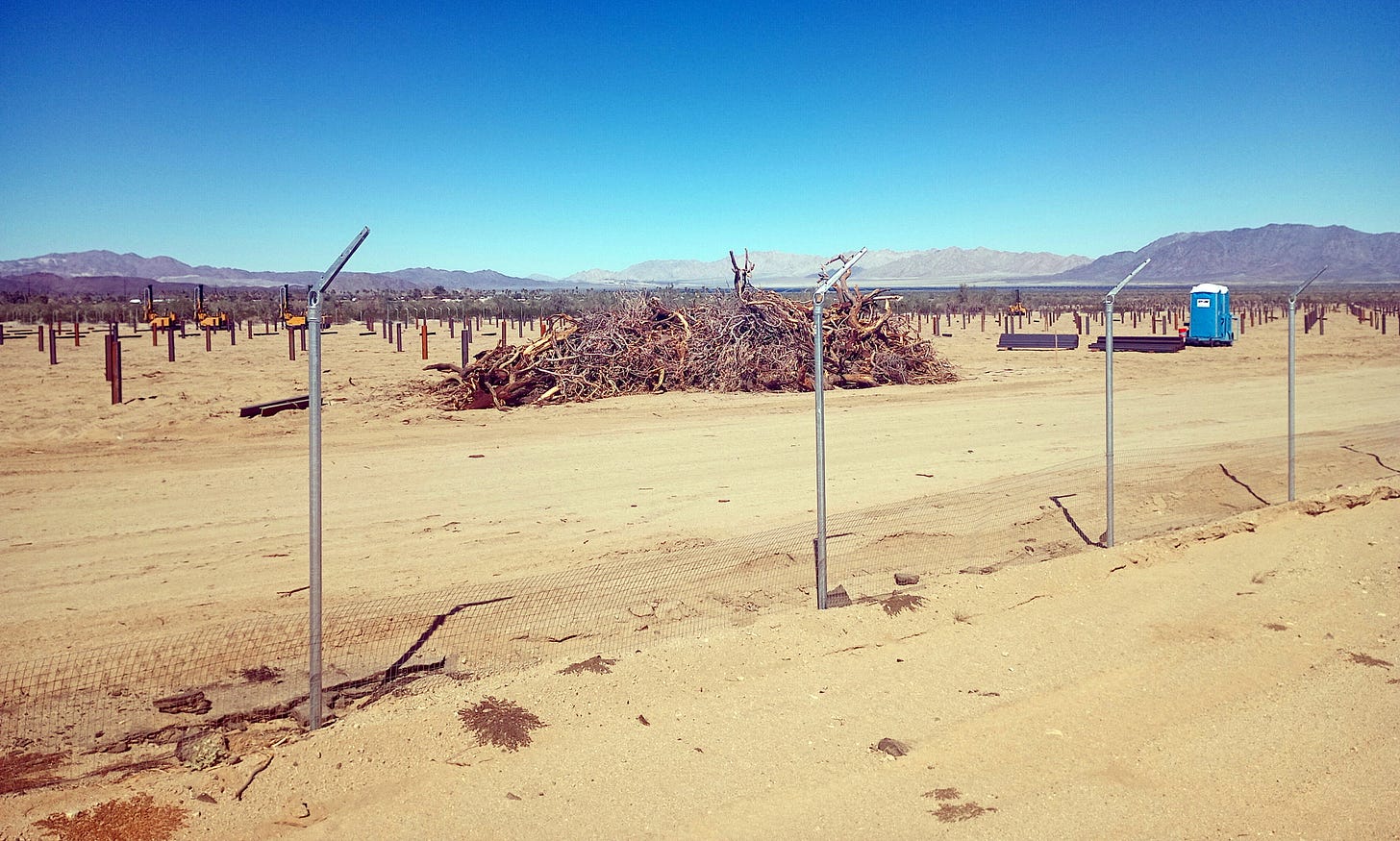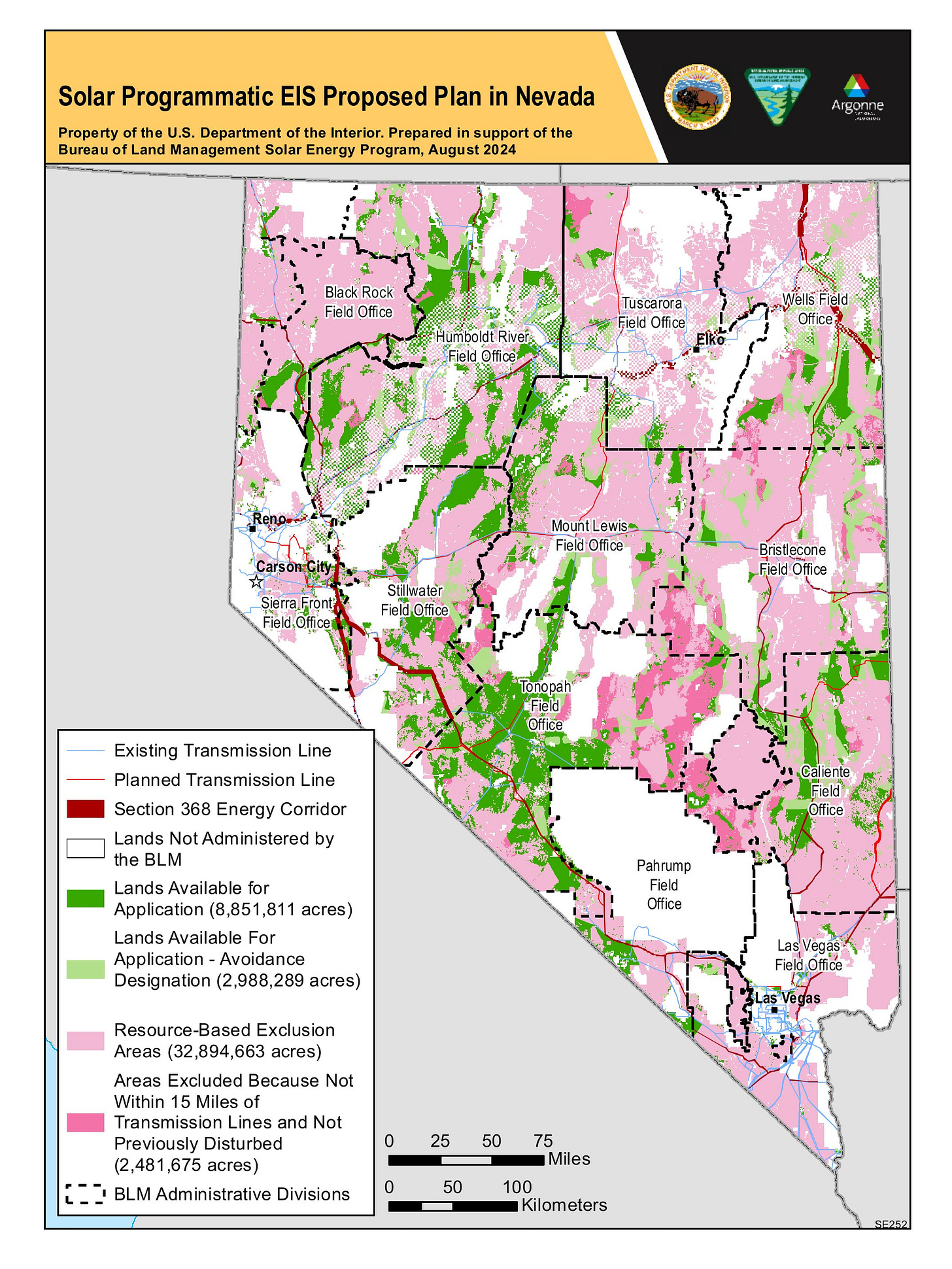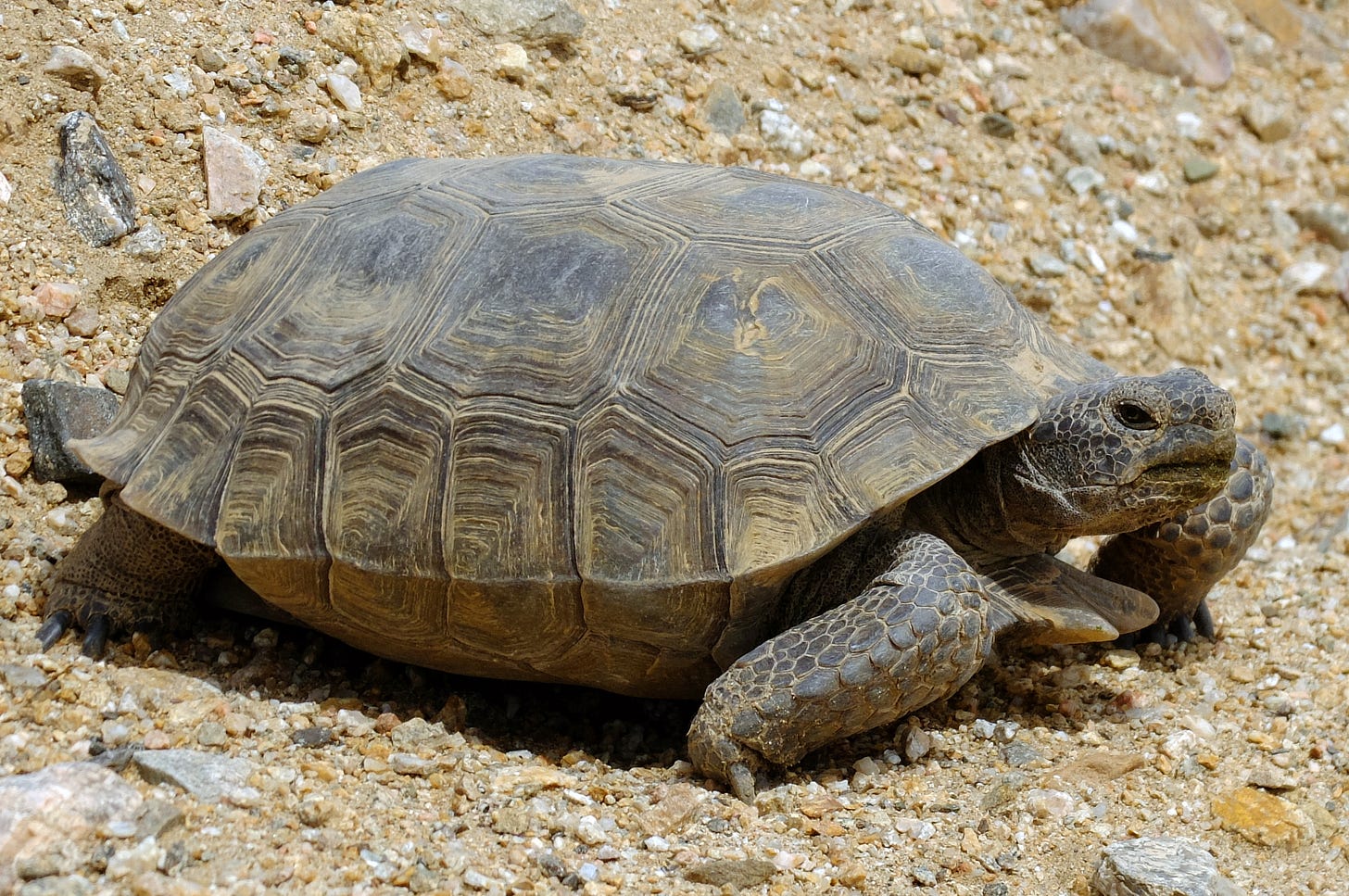

I recently had an exchange with a climate specialist here on Substack that illustrated one of the major problems with current climate discourse. It doesn’t matter who; they do a good job calling attention to important news, and the limitation of their worldview I am highlighting here is not at all unique to them, so I won’t name them. They had put up a post enumerating many of the threats to the environment posed by the incoming Trump administration and its Project 2025, which I certainly appreciate since the more people who call attention to these threats, the better. After expressing that appreciation for their contribution the the topic, I commented:
For the record, a possible silver lining of a Trump administration for some of us is that wildlife habitat, especially in the western deserts, might face fewer threats from industrial green energy projects. For example, Trump's cancellation of the Crescent Peak Wind Project preserved a site that’s within the area that became the Avi Kwa Ame National Monument under Biden.
I was pointing out the paradoxical fact that Trump’s strike against a wind project ended up sparing an area that Biden then saw fit to protect, though Obama had sought to degrade it. I went on to say:
Habitat destruction is the single greatest threat to biodiversity in the world today. The fact that the construction and maintenance of solar farms in California, Arizona, etc., for example, totally wipes out habitat is too often unacknowledged or brushed aside. According to an activist I know who works on these issues, the Desert Tortoise is in danger of being driven to extinction by development in its desert habitat. The Desert Tortoise has been around for 15-20 million years, since the time when the region was a moist jungle, and has managed to adapt to changing conditions slowly but surely. Will the planet now lose this amazing creature for the sake of "sustainability"? That would be an inexcusable tragedy in my opinion.
I’ve had the amazing pleasure of meeting the noble Desert Tortoise twice, once in Joshua Tree National Park, and once in the Mojave National Preserve. I found being in the presence of such an ancient species to be quite powerful. The second encounter was near the Preserve’s northern boundary, just a few miles from the Ivanpah Solar Array, which wiped out over 3500 acres (~5.5 square miles) of wildlife habitat and is a notorious bird killer. Please look at photos of the last spring wildflower bloom at the site, in 2009, as documented by Basin & Range Watch who recently launched their own Substack.
I ended my comment with this:
It's sad and ironic that areas like this, which had so far escaped the worst impact of industrial society because they are inappropriate for agriculture, ranching or urbanization, are now under the gun for ostensibly environmental reasons.
They replied:
While I understand the concern over habitat destruction from green energy projects, we can’t ignore the bigger picture. The existential threat of climate change far outweighs the risks of certain energy projects, especially when we’re already on track to breach the 1.5°C threshold. But that doesn’t mean we shouldn’t seek solutions that balance both. The key is not to pit one environmental issue against another but to address them in tandem, striving for sustainable practices across all sectors.
Note how they refer to the “risks of certain energy projects” [my emphasis] rather than admitting to the well-documented harms of all energy projects. So I responded with more detail:
I agree that we can't ignore the bigger picture. With industrial "green energy" projects, that means taking into account all the environmental effects including habitat destruction that are already baked in before a site is even developed. The manufacturing of solar panels and wind turbines unavoidably entails habitat destruction on its own. Mines for materials are expanded. New mines are set up. Toxic substances are used in the processing of ores and minerals, which affect soil, water, habitat and human health locally. The factories that build the components also produce pollution. I would argue that, in order to balance these costs, we should take further habitat destruction off the table, and only consider locations that are already heavily impacted such as brownsites, parking lots, rooftops, etc. Such siting, closer to the point-of-use, also eliminates the need for long transmission lines from remote locations. Transmission corridors are habitat destruction in their own right, both through their own footprint and through their habitat fragmentation. Plus, the longer the distance, the more power is lost along the way, so this is also a practical matter, about making the most of what's being produced, and wasting as little as possible.
In the bigger "bigger picture" we should be striving to reduce our overall use of energy, so that there is less need for new energy production facilities of any kinds. That's where our calculus of "balance" should begin; with fundamentals. Some such approaches are less sexy than big shiny projects, but would have significant effects: insulating buildings, subsidizing the relocalization of agriculture, and changing zoning laws to make cities less car-dependent.
I disagree that this is about pitting one environmental issue against another. I characterize it as overall harm reduction.
I’ll stress here that I don’t want to see these projects built anywhere, even on brownsites, etc., unless and until we’ve done everything we can to reduce consumption first. Perhaps none would be needed, after all. But in the interest of re-framing the discussion, I was willing to put the idea out there, just to see if they were willing to budge. The lack of a reply suggested that they weren’t.
After re-reading their words I found that I was irked by their advocacy of “solutions that balance both.” So I chimed in one more time:
I've been reflecting on your words, and realized that "balance" here means "compromise." My introduction to environmentalism was through Earth First! circles, whose rallying cry is "No compromise for Mother Earth!" and that one's still with me. [It’s actually “No compromise in defense of Mother Earth!”] You seem to be coming from a different perspective.
And so I have a challenge for you: Find a "green energy" project being planned for an area that is currently wildlife habitat… Before work on the project starts, go spend a few days there camping. Sleep on the ground in a tent or under the stars. Cook something on a fire. Turn off your phone. Walk around and look at all the plants. Observe how different plants grow in different parts of the landscape, depending on their aspect to the sun, the soil type, their proximity to water, etc. Take note of the insects and animals who are interacting with them, for food and shelter. How many of the plants were traditionally used by indigenous people in the area, and for what purposes? (Food, medicine, crafts, etc.) Smell the plants too and taste those that are safe. Spend some time just sitting with your eyes closed and listening. What do you hear? Birds? Wind? Water? Hoofs or padded feet on the ground? Who lives here now? Whose home is this? When the bulldozers come, who can run or fly to safety, but who cannot? Who will lose their food and shelter? Who will be crushed?
Once you take this challenge, if you still feel like it's acceptable to wipe the place out, then okay.
I'm not like that myself. I have visited the proposed sites of various "green energy" projects and have taken note of all of the above. Knowing that such places are on the chopping block is utterly heart-breaking. Knowing that they are being written off in the name of "balance" or "compromise" is enraging honestly. It's very challenging to be as diplomatic as I have been here.
This didn’t even get a “like” and I’m not surprised. But my words there were as much for other readers to see.
The subsuming of environmentalism into “sustainability”
Here we see the problem with focusing on carbon to the near exclusion of all other issues. As I’ve observed in previous posts: over the last few decades, concerns for the environment have been reduced to concerns for the climate, and the subject of climate has been reduced to the subject of carbon, which leaves out both the significant effects on climate of land use and the environmental costs of decarbonization projects. Where once environmentalism was focused on the myriad ways we need to defend nature—protecting wildlife habitat; reducing industrial pollution in water, air and soil; limiting agricultural pesticides; restoring degraded sites; saving endangered species, etc.—now we have “sustainability” which is all about propping up the current global status quo of over-consumption.
Focusing on carbon works well for the establishment because it can be monetized in various ways from carbon credit trading to building out more industrial infrastructure, much of it subsidized by government. Capitalists obsessed with profit and Socialists with “development” can both get on board.
The losers are the flora, fauna and fungi whose homes are destroyed in the process, all over the planet, in increasingly remote places. Here we are in what some scientists consider to be the Sixth Great Extinction, and people want to talk about “balance”? Again, I find this enraging.
This could get a bit awkward...
Earlier this year, he Bureau of Land Management (BLM) released its Western Solar Plan “would make over 31 million acres of public lands across 11 western states available for potential solar development.” They add that these millions of acres will be “driving development closer to transmission lines or on previously disturbed lands and avoiding protected lands, sensitive cultural resources and important wildlife habitat” but that’s a dishonest description of some of the areas they’ve targeted.

I was reassured by a BLM archaeologist who I met socially this last summer that this plan is not a fait accompli; she said it’s just a starting point and that there are people inside the BLM like herself who will be working to decrease the size of the areas from the outset. Her own efforts are on preserving places with archaeological value, including both indigenous and early settler sites. I was grateful to hear that, as the scope of the plant initially shocked me.
And here’s the awkward part: it’s likely that Trump will want to gut the Western Solar Plan, and that climate activists will be pushing back against him on that, but that I will not support them in such a campaign. I’d be happy if “green energy” development of that 31 million acres was taken off the table for the next four years. True, some of it might instead be in the cross-hairs for mining or fossil fuel production, and that’s when I’m back in the fight. But I’d prefer that the creatures who call these places home were given a reprieve from at least one threat until 2029, especially a threat that too many people are willing to write off as “balance.” Maybe history will repeat itself and a Democratic administration taking power next will choose to put some of it into national monuments or otherwise protect it, even though that’s not what they’re interested in doing now.
We shall see. In the meantime, we must remember that once we’ve destroyed a place for whatever reason, there’s no getting it back.
If you find environmental critiques of “green energy” like this informative or thought-provoking, please subscribe. And please share my articles on social media and elsewhere. It really helps get the ideas out to a larger audience.






I appreciate this article. It’s exactly what I was hoping to find on Substack—people thinking differently about important issues. People challenging orthodoxies, even some orthodoxies I have embraced. I agree that the exclusive focus on climate change as THE existential threat is skewing the conservation agenda in unhealthy ways and marginalizing divergent view points. Thanks.
Carbon tunnel vision. It is a widely experienced affliction that leads to blindness regarding other environmental disruptions. I often think part of the reason is that the profit-seekers/takers (politicians, corporations, financial institutions) of our planet discovered a means of monetising carbon so have helped to elevate it to be THE problem that they have THE solutions to (e.g. ‘green/clean’ energy products, taxes, etc.). It’s also a means of continuing to support business-as-usual growth and avoid any discussion around degrowth and contracting/simplifying our existence.